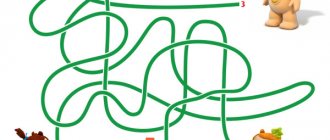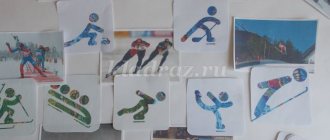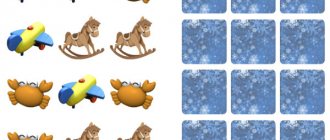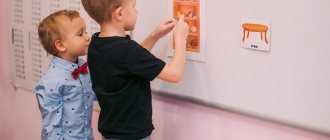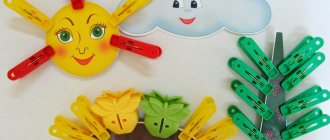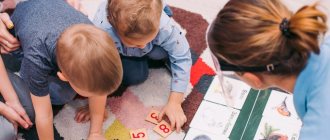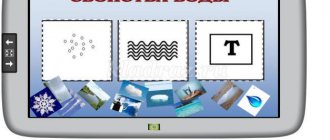Game forms are a universal means of development for preschool children. They contribute to the formation of cognitive processes and the development of the child’s personality. This article provides didactic exercises and games to develop attention in preschoolers. How we develop a child’s attention in preschool age determines how quickly the arbitrariness of this process is formed, and, consequently, the child’s preparedness for school.
Games for younger preschoolers to develop attention
Children aged 3 to 4 years old still have difficulty focusing on speech and verbal exercises. Therefore, in the development of attention it is necessary to use visual perception. It should also be taken into account that the method of cognition in younger preschoolers is visual and effective thinking. Children at this age can look at pictures, repeat actions, and compare objects. These are the games that are suitable for them to train their attention.
- Build like me! Take two sets of cubes of different colors (no more than 5). Sit next to your baby, taking one set for yourself and placing the second one in front of your child. Build a simple structure from your three or four cubes. Invite your child to build the same. If the preschooler succeeded, but without taking into account color, draw his attention to this fact. After praising your child, encourage him to do it again. As the child gets better at it, complicate the designs and add new geometric shapes (cone, cylinder...)
- What do dolls lack? Place three dolls in a row. Tell them what they are going to eat. Place a plate in front of two dolls, a spoon for two more, and also place two cups. Arrange everything so that each doll has two items. There should be utensils on the side, both necessary and unnecessary. Ask the child what is missing from the first doll, the second... Let the child complete the “setting”.
- What have you lost? Draw a simple plot picture: a house, a tree, the sun, a cloud, etc. On a separate sheet of paper, roughly repeat the basis of the drawing from the three main elements. Next, ask your child what else needs to be added, comparing both drawings.
Attention games for middle preschool children
A five-year-old child knows and can do much more than a younger preschooler. He has a vocabulary of 2 thousand words, understands quantitative and qualitative relationships (more - less, stronger - weaker), and perceives verbal instructions. Accordingly, the range of games and attention exercises for preschoolers is expanding.
Exercises based on visual cues
- Lunch for Matryoshkas . Prepare a set of pyramid rings and a set of sticks of different sizes. They will serve as cutlery for the nesting dolls. Set your child the task of choosing a “plate” and “spoon” for each nesting doll in accordance with its height.
- Each item has its place . Place 6 or 8 small items in two rows. Let the preschooler carefully look at what objects are and where they are. The child turns away and counts to three. During this time, the adult swaps 2-4 objects. The child will have to return everything to its place again.
- Hostess . Mix beans, peas and buckwheat in one bowl (a spoonful of each ingredient). The child will have to sort the contents. In the same way, you can mix round, square and triangular buttons, so that the preschooler can then arrange them into three piles. In addition to developing attention, this exercise helps train fine motor skills.
- Attentive buyer. Prepare several drawings consisting of only lines. But the lines are not chaotic. They are the outlines of images of vegetables and fruits. Intrigue your preschooler by the fact that he came to a grocery store that does not have display cases. The seller will only sell those fruits and vegetables that the child finds in the picture. Example drawing:
Games for auditory attention for preschoolers
- Name day. Tell your child that it is the doll’s birthday, and guests will soon come to congratulate the birthday girl. Choose 5-6 toys (these are the guests), giving each one a name. The child seats the guests around a makeshift table and treats everyone to tea, addressing everyone by name.
- Listen to the claps! Agree with the children that they will take a certain pose when they hear the claps. 1 clap – transform into a frog by squatting and touching the floor with your hands; 2 claps – transformation into a stork standing on one leg; 3 claps – free walking. Children move freely around the room and follow commands, listening to the claps.
MAGAZINE Preschooler.RF
“Didactic game as a means of developing attention in preschool children”Prepared by senior teacher N.A. Lipatova
2 Contents Introduction 3 § I. Features of the development of attention in children of senior preschool age. 4 § II. A set of didactic games for developing attention in preschool children 10 Conclusion 17 References 18
3
Introduction During the period of modernization of the education system, providing
continuity of preschool and primary school education, the question arises of the formation in a preschool institution of the prerequisites for educational activities for the further development of educational activities in school.
The development of a child’s cognitive abilities, training of concentrated activity will allow developing attention through didactic games.
Game is the leading type of activity for preschool children. For preschool children, it is of exceptional importance: play is learning for them, play is work for them, play is a serious form of education for them.
Play is a way of understanding the world around us. Developmental and educational
didactic games make learning an interesting activity for the child,
generate interest in the acquired knowledge, skills and abilities. The most important games for children are those in which cognitive processes are improved.
This work will allow teachers to become familiar with the concept of attention,
its types and features of the development of attention in children of senior preschool age. A selected set of didactic games will help the teacher in working on the development of this cognitive process.
4
§ I. FEATURES OF ATTENTION DEVELOPMENT IN SENIOR PRESCHOOL CHILDREN.
Attention is a very important mental process, which is a condition for the successful implementation of any activity of children, both external and internal, and its product is its high-quality implementation.
Attention largely depends on the level of development of the basic processes of higher nervous activity. These processes change with age, and, consequently, attention undergoes changes. The same external stimuli are perceived completely differently by a person depending on age, and cause different reactions in him.
From the point of view of domestic science, human attention has developed
in the process of conscious and labor activity, especially those that required volitional efforts. Many foreign and domestic psychologists dealt with the problem of attention: I.M. Sechenov, I.P. Pavlov, A.A.
Ukhtomsky, V. Wundt, N. F. Dobrynin, P. Ya. Galperin According to its origin and methods of implementation, it is usually
There are two main types of attention: involuntary and voluntary.
Involuntary attention, the simplest and most genetically original,
also called passive, forced, since it arises and is maintained regardless of the goals facing a person.
The activity captures the person in these cases by itself, due to its fascination or surprise. A person involuntarily surrenders to objects, phenomena, and activities that influence him.
As soon as we hear interesting news on the radio, we involuntarily distract ourselves from work and listen. The occurrence of involuntary attention is associated with various physical, psychophysiological and mental reasons.
Voluntary attention is controlled by a conscious goal. It is closely connected with the will of man and was developed as a result of labor efforts,
therefore, it is also called strong-willed, active, intentional. Having made a decision to engage in some activity, we carry out this decision,
5
consciously directing our attention even to what is not interesting to us at the moment, but what we need to do. The main function of voluntary attention is the active regulation of mental processes.
A number of psychologists identify another type of attention, which, like voluntary attention, is purposeful in nature and requires initial volitional efforts, but then the person seems to “enter”
work: the content and process of activity, and not just its result, become interesting and significant. Such attention was called N.F.
Dobrynin post-arbitrary.
Post-voluntary attention is characterized by prolonged concentration, intense intensity of mental activity, and high labor productivity.
In Russian psychology, it is customary to highlight the following properties of attention: concentration; volume; distribution; switching;
sustainability.
• Concentration of attention, that is, the power of concentration on any interesting subject or activity, is not strong enough for an older preschooler. Sometimes an insignificant fact or an object that is hardly noticeable to others causes a distraction in children. That is why it is easier for a teacher to attract children’s attention than to maintain it for a long time. The monotonous type of even interesting activity tires the attention of preschoolers.
• Attention span is highly dependent on a person's past experiences. The amount of attention is characterized by the number of objects,
perceived simultaneously. The numerical characteristic of the average attention span of people is 5-7 units of information. An increase in the amount of attention can be achieved by enlarging information units, combining them into complexes: individual lines are combined into geometric shapes,
sounds - into words or melody, movements - into actions, etc.
6
• The distribution of attention is usually understood as its dispersal into several objects at the same time. The distribution of attention depends on the psychological and physiological state of a person. When tired, in the process of performing complex activities,
requiring increased concentration of attention, the area of its distribution is usually narrowed.
• Switchability of attention is understood as its transfer from one object to another, from one type of activity to another.
This characteristic of human attention is manifested in speed, with
which he can transfer his attention from one object to another,
Moreover, such a translation can be either involuntary or voluntary. Two differently directed processes are functionally associated with switching attention; inclusion and distraction. The first is characterized by the way a person switches attention to something and completely focuses on it; the second is how the process of distraction is carried out.
• Sustainability of attention is an indicator of the depth, duration and intensity of a person’s mental activity.
Stability of attention combines, firstly, the ability to maintain a sufficient level of concentration for so long,
how much is needed for this activity; secondly, the ability to resist distracting circumstances and random interference in work.
Let's consider the features of attention in children 5-7 years old.
Attention in preschool age rarely arises under the influence of any set goal. Consequently, it is involuntary and indicates its low level. A characteristic feature of the attention of a preschool child is that it is caused by externally attractive objects. Attention remains focused as long as interest in the perceived objects remains:
7
objects, events, people.
Attention in preschool age rarely arises under the influence of any set goal. Therefore, it is involuntary. The emergence and development of voluntary attention is preceded by the formation of regulated perception and active proficiency in speech. The better the speech development of a preschool child,
The higher the level of development of perception, the earlier voluntary attention is formed. Concentration, stability, switching are positive properties of attention.
Inattention, absent-mindedness, distractibility are negative properties of attention.
The positive properties of attention are reflected in such features as:
such as calmness, concentration, stability of gaze, stable position of the head, parts of the face, stability of posture, organization of gestures, firmness and confidence of speech.
Negative properties of attention are combined with frequent distraction from the main task, fussiness, imbalance,
chaotic verbosity, darting glances, changing smiles,
surprise, uncertainty, anxiety.
The attention span of preschool children is small. Preschoolers focus on attractive pictures, usually between 12 and 20
seconds Six-year-old children are able to actively and productively engage in the same activity for 10-15 minutes. Six-year-olds are 3-4 times less likely, compared to three-year-old children, to be distracted by foreign objects.
Therefore, children are little able to keep several objects in their field of vision at once. Older preschoolers get used to switching faster from rest to work and from one type of activity to another.
Sustainability of attention depends on the individual characteristics of preschool children. Nervous and sick children are more likely to be distracted than calm and healthy children.
8
At the age of 5-6 years, an elementary form of voluntary attention appears under the influence of self-instruction. Attention is most stable in vigorous activity, in games, manipulation of objects, and when performing various actions. At 6-7 years of age, when processes of excitation begin to be balanced by processes of inhibition, voluntary attention develops.
Attention span depends largely on the child's past experiences and development. An older preschooler is able to keep a small number of objects or phenomena in his field of vision, and can also engage in uninteresting work (on the instructions of an adult), and are less likely to be distracted by foreign objects.
It is important to note that temperamental characteristics influence the properties of attention. The correct understanding and completion of tasks by children and the nature of the relationship between the teacher and children depend on this.
Children with the phlegmatic type maintain stable, focused attention until the completion of any activity; they have difficulty distributing attention and are slow to complete tasks.
In children with a choleric type of temperament, stability and concentration of attention depend on the degree of their awareness of the need for any activity, on the need to carry it out.
The attention of children with a melancholic type of temperament is unstable; it is difficult for them to concentrate and distribute attention due to self-doubt.
Thus, we must teach the child to be “attentive.” At the age of 5–7 years, develop in the child the ability to maintain attention on the same object (or task) for as long as possible, as well as quickly switch attention from one object to another.
Teach the child to subordinate his attention to a consciously set goal (or the requirements of the activity) and notice subtle but significant properties in objects and phenomena.
9
Psychologists believe that the higher the level of development of attention, the higher the effectiveness of learning. It is inattention that is the main reason for children’s poor performance at school, especially in the lower grades.
After all, schooling poses tasks for students that are not similar to those
which he was used to solving in kindergarten during games. The developmental significance of the game is discussed in the studies of R.I. Zhukovskaya, N.Ya.
Mikhailenko, A.P. Usova, D.B. Elkonina and others.
Therefore, didactic games will help both teachers and children to form cognitive processes in activities leading to children of this age.
10
§ II. A COMPLEX OF DIDACTIC GAMES FOR THE DEVELOPMENT OF ATTENTION IN PRESCHOOL CHILDREN
Find two identical objects
Goal: development of thinking, attention span, perception of shape, size,
observation skills, developing the ability to compare and analyze.
Equipment: a drawing depicting five or more objects, two of which are the same; sharpened simple pencils.
Description. The child is offered:
a) a drawing depicting five objects, including two identical ones;
you need to find them, show them and explain the similarities between these two objects;
b) a picture (card) depicting objects and a sample; it is necessary to find an object similar to the sample, show it and explain what the similarities are;
c) a drawing (card) depicting more than five objects, from the depicted objects it is necessary to form identical pairs, show them or connect them with lines drawn in a simple pencil, and explain,
What are the similarities between each pair?
Instructions:
a) Look carefully at this card and find two identical ones among all the drawn objects. Show these objects and explain how they are similar. Get to work.
b) Look, this picture shows objects. Each of them can be found a pair. Connect each resulting pair (two identical objects) with lines and explain how they are similar.
Laying out from sticks.
Goal: development of voluntary attention, fine motor skills of the fingers.
Equipment: counting sticks (pieces of thick insulating wire,
straws for cocktails, etc.), sample pattern.
Description. The child is asked to lay out a pattern or silhouette from
chopsticks
11
a) 1st level of complexity - patterns in one line;
b) 2nd level of complexity - simple silhouettes, consisting of 6 to 12
sticks;
c) 3rd level of complexity - more complex silhouettes, consisting of 6 to 13
sticks;
d) 4th level of complexity - complex silhouettes with a large number of details, consisting of 10 to 14 sticks
Instructions: Look at what is shown in this picture (pattern, house, etc.) Take the sticks and make exactly the same pattern (house...) out of them. Be careful when posting.
Eliminating unnecessary things.
Goal: development of thinking and attention span.
Equipment: a card with a picture of objects, one of which is different from the rest.
Description. The child is asked to find one of the five objects shown in the picture that is different from the others, and
explain your choice.
Instructions: “Look carefully at the objects depicted here and find among them one that is different from the rest. Show the item you found and explain why it is not like the others.
Find differences
Goal: development of voluntary attention, switching and distribution of attention.
Equipment: card with two pictures having
differences.
Description. The child is offered:
a) a series of pictures, two pictures on each card; in each picture you need to find five differences;
b) a card depicting two pictures that differ from each other in details. It is necessary to find all existing differences.
12
Instructions: “Look carefully at this card. It shows two pictures that differ from each other in various details.
It is necessary to quickly find all the existing differences. Start looking."
Laying out a mosaic pattern.
Goal: development of concentration and attention span, fine motor skills,
developing the ability to work according to a model.
Equipment: mosaic, sample.
Description: the child is asked to lay out the mosaic according to the model: numbers,
letter, simple pattern and silhouette.
Instructions: “Look, this picture shows a number (letter, pattern,
silhouette). From the mosaic you need to lay out exactly the same number (letter, pattern,
silhouette), as in the picture. Be careful. Get to work."
Stringing beads.
Goal: development of concentration and attention span, fine motor skills of the fingers.
Equipment: sample for stringing beads; beads corresponding to the sample, or equally cut pieces of colored thick wire insulation; to complicate the task - large beads.
Description. The child is asked to string beads according to the pattern.
Instructions: “Look at these drawn beads. Do you want to collect the beads yourself? I will give you beads and wire on which you need to string the beads one after another exactly as they look in the picture.”
Note. Working with large beads often causes difficulties for children. It is possible to use large beads only in case of well-developed hand motor skills and as a complicating element of the game.
Name the animals.
Goal: development of observation, formation of the ability to distribute attention.
Equipment: drawing depicting camouflaged animals.
Description. The child is given a drawing depicting camouflaged animals, among which he must find wild animals.
13
Instructions: “Look, in this picture the animals are hiding from you.
Start looking for wild animals.”
Copy.
Goal: development of concentration and attention span, formation of the ability to follow a pattern, development of fine motor skills.
Equipment: a blank sheet of paper in a large square; sample for drawing; sharpened pencils.
Description. The child is asked to make two pictures the same
Instructions: “Look carefully at the picture. It depicts a figure consisting of lines. Draw exactly the same figure. Be careful!".
Note. It is not recommended to use a pen or felt-tip pen for drawing. If desired, the child can shade the closed figure with a colored pencil.
Shop window.
Goal: development of attention span and observation.
Equipment: drawing depicting a store window.
Description: The child needs to find (not counting) the box with the largest number of candies and explain his choice.
Instructions: “Look, this picture shows a store window, in
which displays newly arrived candies. They are laid out in transparent boxes of different sizes. Mom told her son to choose any box. The boy wanted the box with more candies. You must help the boy find the box that contains the most candies. Explain your choice.
How can you check if your choice is correct? (You can count.)
Look again carefully at the drawing, think and say why at first glance it seems that there are different numbers of candies in the boxes.
Get to work."
14
Builders.
Goal: development of observation, concentration and distribution
attention.
Equipment: form with four drawings, one of which is a sample, and
the other three differ from the sample in missing parts; simple pencil.
Description. The child is offered a sheet with four drawings containing elements of the tower. The first drawing is a sample, the other three are different from each other and the sample. It is necessary to complete the missing elements so that all three drawings correspond to the sample.
Instructions: “Look carefully at these four pictures. The first of them shows the finished tower, while the other three show the details of the tower unfinished. You need to add the missing parts to each tower so that all four towers are the same. Get to work."
Reproduction of geometric shapes.
Goal: development of voluntary attention, attention span, memory,
thinking.
Equipment: pencil, blank sheet of paper, appropriate size
sample.
Description. The child is asked to look at different geometric shapes,
remember their location so that after 10 seconds you can reproduce them from memory on a blank sheet of paper.
Instructions: “Look carefully at these geometric shapes and try to remember their location. After a while, I will remove the card, and on a sheet of paper you will have to draw these same geometric figures from memory, arranging and coloring them as they were on the sample.”
Name the item.
Goal: development of integrity of perception, formation of the ability to classify, incorporate parts into the whole, and concentrate attention.
15
Equipment: drawings with disguised images of objects
(toys, fruits, dishes, vegetables).
Description. The child is offered a drawing with a disguised image of objects. It is necessary to see and show each of the items separately.
Instructions: “Look carefully at this unusual drawing. It depicts camouflaged objects. It is necessary to see and show each item separately. Get started with the task."
Note. At the first stage of work, it is advisable to invite the child to follow the contour of each object with a pointer. In the future, when the child masters the task with a pointer, you can invite him to follow the outline of the object with his eyes.
What do you hear?
Goal: development of auditory attention.
Equipment: objects that make sounds familiar to children; screen.
Description. The presenter invites the children to listen and remember what is happening behind the door or screen. He then asks to tell what they heard. The winner is the one who identifies the sound sources more and more accurately.
Instructions: “Now we will play the game “What do you hear?” and find out who is the most attentive. You need to listen carefully to what is happening outside the door in complete silence for some time (I time it)
(screen). At the end of this time (1-2 minutes), you need to name as many sounds heard as possible. In order for everyone to be given the opportunity to speak, it is necessary to name the sounds heard in the order of their turn. You cannot repeat sounds when naming. The one who names the most of these sounds wins
Note. You can play with a group of children or with one child.
The order in the game can be set using a counting rhyme.
Items that can be used to play: drum, whistle,
wooden spoons, a metallophone, a children's piano, containers with water for her
16
pouring and creating sounds of pouring water, glass objects and a hammer for knocking on glass, etc.
Four forces
Goal: development of attention, coordination of auditory and motor analyzers.
Description. The players sit in a circle and perform movements in accordance with the words: earth - arms down, water - stretch your arms forward, air - raise your arms up, fire - rotate your arms at the wrist and elbow joints. Whoever makes a mistake is considered a loser.
Instructions: “For this game you need to sit in a circle and listen carefully. If I say the word "earth", everyone should put their hands down,
if the word “water” is to stretch your arms forward, the word “air” is to raise your arms up, the word “fire” is to rotate your arms at the wrist elbow joints. Whoever makes a mistake is considered a loser."
Listen to the claps
Goal: development of voluntary attention.
Description. Children moving in a circle take poses depending on the leader’s command: one clap - take the stork pose (stand on one leg,
hands to the side); two claps - frog pose (sit down, heels together, toes to the sides, hands between your legs on the floor); three claps - resume walking.
Instructions: Now we will play an interesting game “Listen to the claps!”
All players will have to walk in a circle one after another and listen carefully to my commands. When I clap my hands once, everyone must stop and take the “stork” pose (demonstration of the pose). If I clap my hands twice, everyone must stop and take the “frog” pose (demonstration).
When I clap my hands three times, you need to resume walking one after another in a circle. Let's start the game.
Who's flying?
Goal: formation of attention, development of the ability to highlight the main,
essential features of objects.
Equipment: list of item names.
17
Conclusion The attention of a preschooler primarily reflects his interests in
relation to surrounding objects and actions performed with them.
The child is focused on an object or action only until his interest in this object or action fades away. The appearance of a new object causes a switch of attention, so children rarely do the same thing for a long time.
If attention is not specifically developed, there is a decrease in the ability to concentrate, distribute, hold, switch, which leads to difficulties in mastering program material, and subsequently to failure at school age.
Game is one of the forms of educational influence of an adult on a child. IN
At the same time, play is the main activity of children. Thus, the game has two goals: one of them is educational, which is pursued by an adult, and
the other is a playful one, for the sake of which the child acts. It is important that these two goals complement each other and ensure the development of the child’s attention
18
Bibliography
1. Baskakova, I.L. Attention of a preschooler, methods of its study and development. Studying the attention of schoolchildren. [Text] I.L. Baskakova. – M.: Publishing house “Institute of Practical Psychology”, Voronezh: “MODEK”, 1995. – 64 p.
2. Boryakova, N.Yu., Soboleva, A.V., Tkacheva, V.V. Workshop on the development of mental activity in preschool children [Text] N.Yu. Boryakova, A.V. Soboleva, V.V. Tkacheva: Educational and methodological manual for speech therapists, educators and parents! Ed. Prof. T.B. Filicheva. – M.: “Gnome-Press”; 2000. – 64 p.
3. Z. M. Boguslavskaya, E. O. Smirnova Educational games for preschool children. A book for kindergarten teachers. – M.: Education, 1991.
4. Galperin, P.Ya. On the problem of attention. [Text] P.Ya. Galperi APN RSFSR. 1958. No. 3. P.33-38.
5. T. N. Doronova, O. A. Karabanova, E. V. Solovyova Playing in preschool age: a manual for kindergarten teachers. M.: Publishing house “Education of preschool children”, 2002.
6. Mikhailenko N.Ya., Poddyakov N.N. “Problems of preschool play. Psychological and pedagogical aspect." – M.: Pedagogy, 2007. – 154 p.
7. Nemov, R.S. Psychology [Text] R.S. Nemov: Textbook for students. higher ped. textbook institutions: In the third book - 4th ed. - M.: Humanit. Ed. VLADOS Center, 2000.- book. 1: General fundamentals of psychology. - 688 p.
| Next > |
Exercises to develop attention in older preschoolers
Games for older preschoolers to develop attention are more complex. They require concentration, concentration, and also contribute to the formation of knowledge and skills necessary for entering school. Find out what your child should know by 1st grade.
Games actively involve memory and verbal logical thinking. In addition, they often contain a competitive condition, according to which the most inattentive are eliminated from the game. Older children are encouraged by such exercises, and they then perform them with interest without the participation of an adult.
- Look around. This game can be played anywhere. It is enough to decide what you need to see in your immediate environment. For example, on the way to kindergarten or to the store, name everything that has a round shape. Or focus on the perception of color and name yellow and green objects.
- Remember the pictures. Pre-prepared cards with the image of one object are used. Pictures of 10-12 pieces are laid out in a row, and the preschooler looks at them for 1-2 minutes. Then the cards are removed, and the child lists all the images that he remembers. The exercise also develops operational visual memory.
- Fish-bird-beast. A group game in which one person is the leader. The presenter, in the form of a counting rhyme, points to each participant and says: “fish-bird-beast-fish...”. This chain is repeated as much as the leader considers necessary. He can stop at any of these words and, pointing at the participant, become silent. This means that the participant must name a specific type of fish, bird or animal (depending on the last word). Names cannot be reused. If the answer is correct, the game continues with the same lineup. If a player gives an incorrect answer, he is eliminated from the game. Waiting for an answer is limited to counting one-two-three.
- Repeat and complete. It is better that 4-7 people take part in the game. The first participant names the word, the second repeats the word he heard and adds his own. The third one repeats the words that were spoken and completes the chain with his own word. The one who makes a mistake is out of the game.
- Listen - do it. Exercise helps develop attention and memory. The adult names a chain of actions without demonstrating them. He speaks slowly the first time, and repeats the second time at a normal pace. After this, the children reproduce the movements in the same order as listed by the presenter. Some examples of actions:
- Raise your right hand in front of you, raise your left hand up, lower both hands.
- Turn your head to the right, raise your left arm to the side, turn your head straight, raise your right arm to the side, lower your arms.
- Raise your left leg, clap your hands, lower your leg, jump.
This game is especially interesting for children if several people take part. Even the most absent-minded children try to listen and carry out all the actions.
The games presented in this article can be used for activities with one child or with a group of children. It’s great if an adult acts not only as an organizer, but also as a partner. Moreover, many exercises do not require special conditions. You can play with your child to benefit his attention during the most ordinary walk in the park.
When selecting exercises to develop attention in preschoolers, adhere to the principles of moving from simple to complex and the attractiveness of tasks. Also take into account the characteristics of the child’s temperament that affect the speed of switching attention.
Learning to concentrate
In elementary school, a child will need not only perseverance, but also the ability to follow the progress of the lesson. The assimilation of information depends on attentiveness and memory.
As a game they offer simple encryptions that are easy to compose. To do this, you need to take 10 letters and numbers up to 10. As a result, 1 letter will be represented by 1 number.
Children receive cards indicating which number represents which letter. For example, 1 - b, 2 - o, 3 - a, 4 - c, etc. The code - 304 - is left on the card, the child matches it with the key and gets the word “bass”.
Dances of the peoples of the world for children: Indian, Irish, Chinese dances
In lower grades, you can use the game “Corrector”. Children are given a printed text and told which letter to cross out. A limited amount of time is allotted for completion.
To develop visual attention, tasks like “find the differences”, “compare”, mazes, etc. are suitable. All material is selected according to age.
5 best exercises for schoolchildren
Every day you need to concentrate for a while on what is happening around you. Analyze sounds, noise around and notice the smallest details. This can be done within five minutes. This exercise allows you to learn to notice features of the environment.
Any daily activities must be performed consciously. This concentration will allow you to become accustomed to constant attentiveness. Even while washing dishes or wiping the floor, the child must be focused.
Important! The development of higher mental functions needs to be given time every day. This way you can gradually improve them.
It is useful for a student to develop the skill of seeing all the details of an object. It is enough to take any one thing and try to name its seven main qualities.
To develop stability of attention, use a simple exercise. Draw a straight line on a white sheet of paper. As soon as the child is distracted, he should draw a line up.
At school, some teachers use presentations for work. Not all students can easily perceive them. To develop concentration, you need to teach the student to abstract from external stimuli. Meditation will help with this.
In physical education lessons you can also develop attention. To do this, they use relay races and games that are aimed at memorizing the sequence of movements - five or six options are enough.
Physical activity has a beneficial effect on brain function
Many tasks can be printed out and used at home. Stores sell special workbooks that contain a selection of thematic tasks.
Preparing for school: learning to concentrate
The last year of kindergarten is very important for a child's development. During this period, the foundation is laid for the formation of writing, reading and mathematical abilities.
A preschooler needs to be gradually accustomed to lessons. Due to his age, it will be difficult for him to sit in one place for a certain amount of time. Therefore, you need to immediately develop this skill.
Important! During the lesson, nothing should distract the child: requests from parents, the TV on, etc.
Listening to classical music and reading books can help you develop the habit of focusing. There is another useful exercise: you will need a simple watch for it. You need to look only at the second hand for one minute and watch only it.
The development of attention, memory, and thinking occupies a key place in preschool age. To do this, use special games and exercises that help improve brain function.
